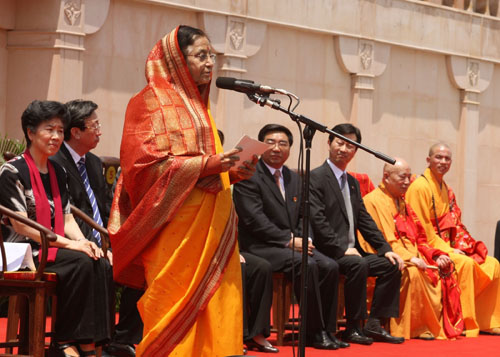Speech by Her Excellency the President of India, Shrimati Pratibha Devisingh Patil at the White Horse Temple
Luoyang, China : 29.05.2010
 Reverend Yin Le, Chief Abbott of the White Horse Temple,
Reverend Yin Le, Chief Abbott of the White Horse Temple,
Ladies and Gentlemen,
It gives me great pleasure to be here in Luoyang to dedicate the Indian-style Buddhist Temple in the White Horse Temple complex, to friendship between the people of India and the people of China.
Luoyang is widely considered to be the cradle of Chinese civilization. The White Horse Temple, being one of the first Buddhist Temples in China, has been a cultural and spiritual centre for centuries. Historically, it has the unique distinction of symbolizing an inter-mingling of Indian and Chinese cultures. As the resting place of two great cultural ambassadors from India, the monk-scholars Kashyapamatanga and Dharmaratna, it is a reminder of how our civilizations enriched each other.
Located is such a significant place, the Indian-style Buddhist Temple is a gift from the people of India to a sister civilization - one with which we share so many valuable associations and memories of interaction. It is particularly appropriate that this inauguration takes place during the 60th Anniversary year of the establishment of diplomatic relations between the Republic of India and the People's Republic of China. Even though we are young nations, we are ancient civilizations. Our civilizational contact dates back several millennia. Undoubtedly, Indian monks contributed significantly to Buddhism in China. Equally remarkable was the role played by Chinese travellers and scholars such as Fa Xian, Xuan Zang and Yi Jing, whose writings not only enriched Chinese literature, but also proved to be a remarkable source of understanding of India's own ancient history. As an example, Xuan Zang is an important figure in all history text books in India. I am confident that the Indian-style Buddhist temple will also be perceived by generations to come as a testimony of our friendship.
The Indian-style Temple has the architectural impression of the Sanchi Stupa and the image of the Sarnath Buddha, the two most important icons of Buddhist architecture in India. Its construction is the outcome of dedicated work of countless individuals and organizations in the two countries. It has been a labour of love for the Indian craftsmen who worked painstakingly on the beautiful carvings and artistic decorations that adorn it. I would like to appreciate and thank them all. Three of them are with us here today - Akshaya Jain, Raka Chakravorty and Dilip Kumar Nag. Similarly, the temple is also the result of valuable assistance provided by the Chinese authorities. I take this opportunity to thank them, especially the Provincial Government of Henan and the city authorities of Luoyang, for their efforts in realizing this monument of India- China friendship.
I hope that this shrine will further enhance people-to-people contact between India and China by encouraging greater exchange in the current age and in times to come.
Thank you.








